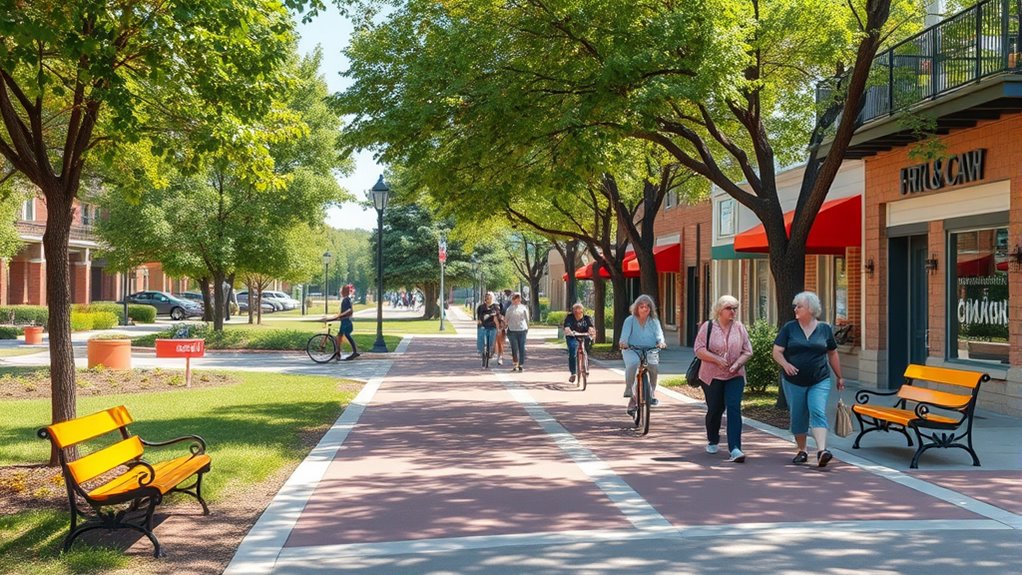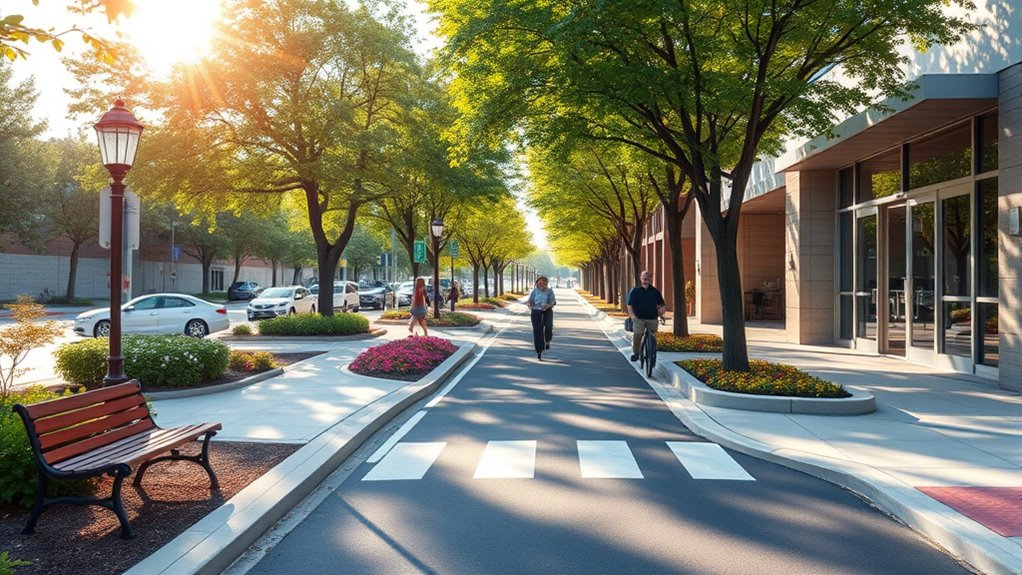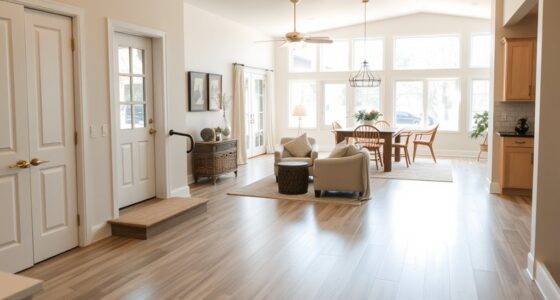An age-friendly neighborhood offers accessible public transportation, allowing you to get around easily and stay connected to essential services. It features natural spaces that promote relaxation and social bonding, while community engagement encourages you to participate actively and feel valued. Inclusive design and vibrant social networks create a safe, lively environment where older adults thrive. To discover how these features come together to support your well-being and independence, keep exploring further.
Key Takeaways
- Accessible public transportation systems that support mobility and independence for seniors.
- Natural environments and biodiversity hotspots that promote mental well-being and social cohesion.
- Active community engagement allowing residents to participate in decision-making and neighborhood initiatives.
- Inclusive neighborhood design fostering social relationships and a sense of belonging for older adults.
- Well-connected amenities ensuring easy access to healthcare, shopping, and social activities.

Creating an age-friendly neighborhood means designing communities that support residents of all ages, especially seniors. One of the most critical features is accessible and reliable public transportation. When public transit options are convenient and easy to use, seniors can maintain their independence without relying solely on family or friends. Public transportation that accommodates mobility aids, offers frequent service, and is affordable ensures that older adults can easily reach essential services like healthcare facilities, grocery stores, and social activities. Having a well-connected transit system reduces feelings of isolation and helps seniors stay engaged with their community, which is essential for their mental and emotional well-being. It also encourages social interaction, minimizes loneliness, and fosters a sense of belonging. Incorporating public transportation options into community outreach or informational campaigns can enhance communication and understanding about available services. Additionally, a well-designed transit network can support the psychological well-being of older adults by reducing anxiety about mobility limitations. Studies also show that accessible transportation reduces the need for costly healthcare interventions by promoting preventative care and regular medical visits. Moreover, integrating biodiversity hotspots within urban planning can provide calming natural environments that promote mental health and social cohesion for residents. Community engagement plays an crucial role in creating an age-friendly neighborhood. When residents actively participate in local decision-making, events, and volunteer opportunities, they help shape a community that truly meets everyone’s needs. As a resident, you can get involved in neighborhood councils, attend town hall meetings, or volunteer for local programs aimed at seniors. This engagement not only provides opportunities for social connection but also ensures that the voices of older residents are heard when planning improvements or services. Community involvement fosters mutual support among residents, creating a safety net that enhances overall well-being. It encourages collaboration among different age groups, making the neighborhood more inclusive and resilient. When community members work together, they can identify barriers that seniors face and develop practical solutions—like installing benches in public spaces or organizing transportation services—that improve daily life for everyone. Such collaborative efforts can also lead to innovative solutions, like integrating smart home devices with community resources to assist seniors in maintaining independence. Designing a neighborhood with community engagement and accessible public transportation in mind creates an environment where seniors feel valued and empowered. It transforms the area into a place where they can easily move around, participate in activities, and build meaningful relationships. When transportation is reliable, and community members are involved, older adults are more likely to stay active and socially connected, which directly impacts their quality of life. These features also benefit the broader community by fostering a sense of shared responsibility and pride. Creating an age-friendly neighborhood isn’t just about accommodating seniors; it’s about building a vibrant, inclusive community that supports the diverse needs of all its residents. By prioritizing accessible transportation options and active community participation, you help lay the foundation for a neighborhood where everyone can thrive. Recognizing the importance of community involvement can lead to more sustainable and adaptable neighborhood planning that benefits all generations.
Frequently Asked Questions
How Do Age-Friendly Neighborhoods Impact Mental Health?
You might notice that age-friendly neighborhoods greatly boost your mental well-being by promoting social connectivity. When you can easily connect with neighbors and community groups, you feel less isolated and more supported. These environments encourage social activities and safe spaces, which reduce stress and enhance your overall mental health. Staying socially engaged in an age-friendly neighborhood helps you maintain a positive outlook and emotional resilience as you age.
What Role Does Technology Play in Age-Friendly Communities?
Imagine a bridge connecting you to everything you need—that’s what technology does in age-friendly communities. Digital connectivity keeps you linked to loved ones and essential services, while smart home technology enhances safety and comfort. You actively benefit from these innovations, making daily life easier and more independent. Technology isn’t just a tool; it’s a lifeline that fosters engagement, security, and a sense of belonging in your community.
Are Age-Friendly Features Affordable for All Residents?
You’ll find that age-friendly features can be affordable when communities focus on cost-effective solutions and prioritize community engagement. By involving residents in planning, you help identify practical, budget-friendly options that meet everyone’s needs. This collaborative approach guarantees that amenities, transportation, and safety measures are accessible without breaking the bank, fostering an inclusive environment where all residents benefit from thoughtful, affordable improvements.
How Can Residents Advocate for Neighborhood Changes?
You can advocate for neighborhood changes by engaging in community participation and voicing your needs. Attend local meetings, join neighborhood groups, and share ideas for improvements. Use policy advocacy to influence decision-makers, highlighting the importance of age-friendly features. Your involvement helps shape policies that create accessible, inclusive environments, ensuring everyone benefits from a safer, more supportive neighborhood. Active participation makes your voice heard and drives positive change.
What Are Examples of Successful Age-Friendly Initiatives Worldwide?
Imagine cities where young and old share spaces, fostering connection. Successful age-friendly initiatives include intergenerational programs that promote understanding and accessible transportation that guarantees everyone gets around easily. Cities like Stockholm with their universal design and Singapore’s community centers demonstrate how these efforts create vibrant, inclusive neighborhoods. You can learn from these examples to support or develop initiatives that make your community more welcoming for all ages.
Conclusion
So, while designing age-friendly neighborhoods promises safety and comfort, it’s amusing how often we overlook the simplest joys—like a friendly chat or a leisurely walk. Ironically, creating an environment that truly cares for everyone means embracing the imperfections and spontaneity of life. Because in the end, the most valuable feature isn’t the perfect sidewalk or the best lighting, but the genuine sense of community that makes aging feel less lonely and more connected.









